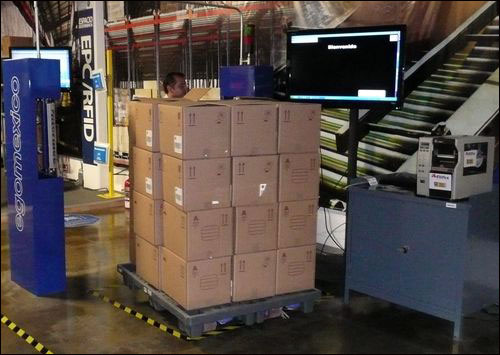Deployments of radio frequency identification technology in Mexico, as in the rest of Latin America, have lagged behind those in the United States and in European countries. But GS1 Mexico is following the lead of GS1 organizations in Canada, Germany and elsewhere in creating a Knowledge Center that can be utilized to educate companies about the Electronic Product Code (EPC) and other GS1 standards.
GS1 Canada launched its Knowledge Center in 2008 to educate Canadian businesses—particularly small and midsize enterprises (SMEs)—about how they can become more competitive by employing technology based on GS1 specifications (see GS1 Canada Launches Knowledge Center). GS1 Mexico has similar goals for its new Knowledge Center, which opened on Mar. 23.

Last month, RFID Journal had the opportunity to tour the new facility, which features training rooms and six demonstration areas, or labs, in which Mexican businesspeople can see how standards are implemented in the real world, and put into practice what they learned during educational sessions.
“The goal is to promote standardization and best practices in Mexico,” says Omar González de los Cobos, GS1 Mexico’s standards development specialist. “We do training, and the trainees can come into the labs and practice what they’ve learned, to ensure they are doing it properly. For example, attendees can practice encoding tags with EPCs.”
One demonstration area features an impressive array of radio frequency identification technology, and reveals how EPC standards work in action. One corner of the RFID lab shows how hangtags can be printed at a manufacturing facility, how those tags can be read when goods are placed in a carton for shipping, and how software can confirm that the proper items have been picked, and that the correct cartons have been put on a pallet.
Another application shows two portals, including one that has a gate with an arm that rises to allow entry. Both portals are equipped with RFID readers, set up to interrogate pallet tags. If the pallet is one expected for delivery, software will flash arrows on an LCD screen indicating that the delivery can pass through the gate. If that pallet is at the wrong dock door, the system will display the location of the correct door. And if the pallet should not be delivered to that facility, the screen will indicate that as well.
Another corner of the RFID lab shows the back of a store, and utilizes Tyco Retail Solutions‘ TrueVue software to record items entering inventory in the back room. No readers or antennas are visible in the area of the lab set up to demonstrate retail applications. There is an RFID-enabled mirror that displays information about products being tried on, as well as an interactive sunglass kiosk, similar to the one used at the Common People store in Mexico City (see RFID Makes Common People an Uncommon Store).
GS1 Mexico’s employees demonstrate to visitors how inventory can be counted by means of a handheld reader, how items can be checked out at the point of sale using EPC tags, and how replenishment orders can be created in the software application that records each sale.
“It’s very important for us to show the technology and EPC standards can be used to streamline processes and reduce costs in the supply chain in Mexico,” González de los Cobos states. “The market is skeptical about RFID right now, so our main goal is to educate and demonstrate the functionality of the technology, and benefits of the standards.”
But unlike other GS1 labs, the GS1 Mexico facility does not focus solely on EPC standards, technology and applications. The other five demonstration areas are devoted to data quality and management, payment slips and invoices, traceability and visibility, processes for SMEs, and distribution-center standards and processes.
The data-quality area deals with ensuring data synchronization via the Global Data Synchronization Network, a network of databases that store product information based on GS1 standards. And the payment slips and invoices area works toward creating standardized bar codes that businesses partners could scan in order to capture information indicating which personnel submit invoices.
“Invoices seem very simple, but the reality is that many companies use bar codes for their own internal benefit, and there is no standardization,” González de los Cobos explains. “Our goal is to educate businesses about the benefits of standardizing invoice bar codes, which reduces costs and expedites payment.”
Any Mexican company wishing to visit the Knowledge Center can call the facility and make a free appointment. Additionally, GS1 Mexico provides interactive workshops, including training, education, consulting, project implementation, developing best practices for using standards, and creating manuals and implementation guides.
“We assist smaller and big companies that want to use GS1 standards,” González de los Cobos says. “We do consulting and explain how to do the implementation, and how to deploy the standards. Some smaller companies think the cost is too high, but that’s not the case. They can benefit from standards just as much as larger companies.”

